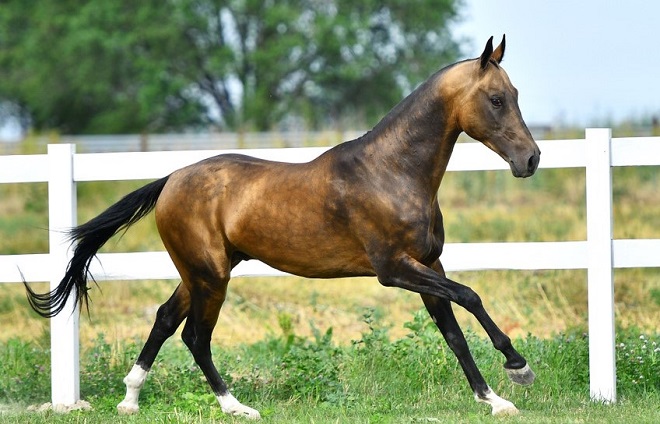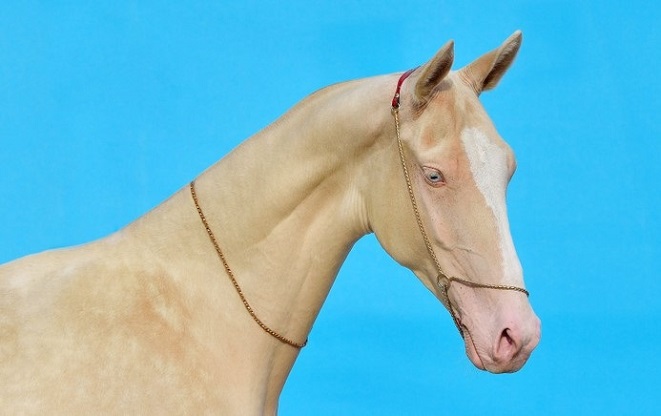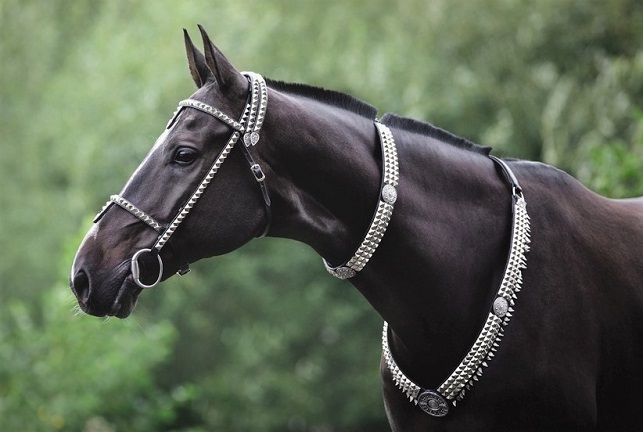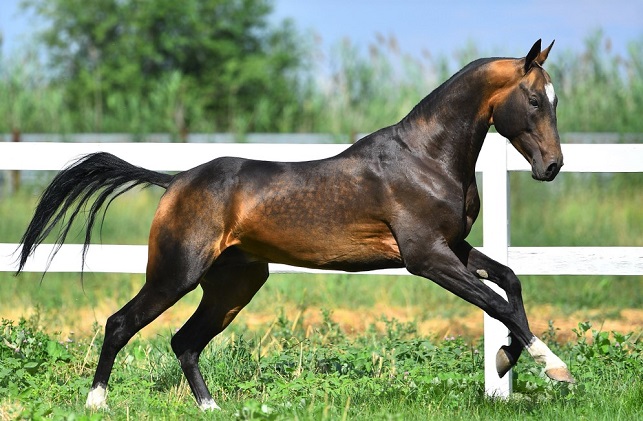The Akhal-Teke is an oriental horse breed originating in the Karakum desert of Turkmenistan. The Teke tribe established the breed thousands of years ago within the Akhal oasis line, hence “Akhal-Teke.”
Akhal-Teke horses are truly unique in their appearance, character, and abilities. They have long, sleek bodies with extremely fine skin and almond-shaped eyes.
Known for their distinctive metallic sheen, they are often cream or palomino, but occur in all solid colors.
The Akhal-Teke breed is infamously hardy with superior speed and stamina. They are generally 14.2 to 16 hands tall and have strong hooves ideal for traveling on desert terrain. The breed’s conformation remained relatively unchanged throughout the ages.
Here are ten interesting facts about Akhal-Teke horses.
1. Akhal-tekes Are One of the Oldest Horse Breeds
The Akhal-Teke is thought to be at least 3,000 years old. Some sources believe it even precedes the Arabian horse (See: The Livestock Conservancy).
The Akhal-Teke descended from one of the four types of horses that migrated from Alaska to Eurasia around 2-3 million years ago.
Many consider the Akhal-Teke, a direct descendant of the ancient Turkoman horse; others claim they are the same breed. The Turkoman is a now-extinct horse breed that dates back to 3000-4000 BC and influenced many modern horse breeds.
The exact origins of the Akhal-Teke are obscure due to the lack of reliable documentation. According to the International Museum of the Horse, the original records couldn’t be correctly translated into English and contain many inaccuracies.

arthorse / Shutterstock.com
The most widely accepted theory is that nomadic Turkmen tribes selectively bred Akhal-Tekes for speed and endurance. For centuries, they primarily used them for transportation and raiding, as well as flat racing. Because of its outstanding qualities, the Akhal-Tekes became one of the most sought-after war horse breeds in the ancient world.
The breed has several names throughout history, including Nisean, Parthian, and sacred/heavenly horses. Several historical writers mention them in their works, such as Oppian and Herodotus.
2. Akhal-Tekes Have Many Unique Survival Adaptations
Having developed in a desert environment, Akhal-Tekes can withstand extreme heat and cold. They were essential to the survival of central Asian tribes, who migrated long distances in the desert. Food and water supplies were scarce for both horses and humans; thus, the Akhal-Teke became extremely hardy and tough.
Adaptations to a hot climate can still be seen in the Akhal-Teke today. Their thin skin and light coat ensured the horses could withstand the desert heat, while their sandy colors hid them from predators.
What’s more, Akhal-Tekes have a unique leg conformation that’s different from other breeds. In most horses, the fetlocks of the front legs are longer and more sloping than on the hind legs. This pattern is reversed in the Akhal-Teke, again indicating their adaptation to sandy terrain.
Also, please read our article on 8 weird and unique horse breeds.
3. Akhal-Teke Horses Excel in Endurance Riding
Above all, Akhal-Teke horses are most famous for their endurance. According to the International Encyclopedia of Horse Breeds, the horses were traditionally fed a low-bulk high-protein concentrate that included eggs and butter mixed with barley.

arthorse / Shutterstock.com
In an attempt to save the breed and show off the horses’ courage, endurance, and strength, a group of Turkmen riders performed an incredible feat. They rode their Akhal-Tekes from Ashgabat, the capital of Turkmenistan, to Moscow in just 84 days, covering a distance of 2,500 miles (4,023 km). They also crossed 225 miles (362 km) of desert land with little to no water. This astonishing ride was repeated in 1988.
Another prominent example of the Akhal-Teke’s endurance was the ride of French poet Laurence Bougault. In 2009, he rode his horse Almila from Isfahan, Iran, to Paris, crossing Turkey, Greece, and Italy on the way. The pair covered a jaw-dropping 4,000 miles (6,500 km) in less than six months.
4. A One-Person Horse
The Akhal-Teke is famously dubbed “the horse of a single master.” Those who work with them believe they can only bond with one person in a lifetime, which is not typical of horses in general.
Some people claim there have been instances of Akhal-Tekes being protective of their owners and refusing to let anyone else ride them.
Throughout history, the loyalty of the Akhal-Tekes has been cherished just as much as their speed and stamina. To this day, many horses are treated as family members and dressed in extravagant clothing to show their importance.
5. The Akhal-Teke Is a Rare Horse Breed
There are around 6,600 Akhal-Teke horses in the world, making them a rare horse breed. The largest populations are in Turkmenistan and Russia, but they are also present in Europe and North America.
The Akhal-Teke breed is on The Livestock Conservancy’s Conservation Priority List (CPL) and is considered “threatened.” According to the Endangered Species Act, a “threatened” status applies to “any species that is likely to become an endangered species within the foreseeable future throughout all or a significant portion of its range.”
One of the major players that contributed to the breed’s decline was the Soviet Union. Due to political and economic instability in the country, many breeding operations established in the late 1800s were forced to shut down. Akhal-Tekes gradually fell out of favor, resulting in plummeting breed numbers.

arthorse / Shutterstock.com
You may be wondering, why didn’t the Akhal-Teke regain its popularity in today’s society? The truth is, the breed’s traditional conformation and temperament make it unsuitable for most FEI disciplines.
Luckily, breeders are improving the Akhal-Teke’s athleticism and trainability, so the breed can survive for future generations to see. (Source: Horsetalk.co.nz)
6. They Have a Peculiar Trot
Not many people know that Akhal-Tekes don’t display the two-beat trot commonly seen in most other horse breeds. A study led by Phil Case who first imported Akhal-Tekes to the United States revealed the interesting truth.
Instead of using diagonal pairs of feet to trot, Akhal-Teke horses step down with each foot. This produces a smoother trot that’s more efficient over long distances and more comfortable for the rider.
Akhaltexas describes the breed’s trot as a “fluid, light, and elegant movement that is floating low over the ground while being comfortable, soft, and not choppy for the rider.”
7. The Silky Hair of Akhal-Teke Horses Creates a Metallic Sheen
Akhal-Tekes aren’t called “Golden Horses” for no reason. Their coat has a unique metallic shine that’s especially noticeable in cream, palomino, and dun horses.
The International Association of Akhal-Teke Breeding explains how this glossy sheen is created. It has to do with the quality of the Akhal-Teke’s hair, which is particularly fine and silky. Layers of this hair create a surface that reflects the sunlight, making these beautiful horses shine like gold.
Also Read: 12 Most Beautiful Horse Breeds in the World
8. The Akhal-Teke Influenced Many Modern Horse Breeds
Akhal-Teke horses have been around for thousands of years, so it’s not surprising that their influence can be seen in many modern horse breeds. The Akhal-Teke is also one of the three existing hot-blooded breeds, alongside the Arabian and the Thoroughbred.
The predecessor of the Akhal-Teke, the Turkoman horse, played a major role in creating the modern Thoroughbred breed. Byerley Turk, one of the three founding sires of the Thoroughbred, likely had Turkoman breeding. The stallion was captured during the Turkish occupation of Budapest and brought to England, where he established his sire line.

vprotastchik / Shutterstock.com
A 2017 research paper found proof through the testing of the Y chromosome that the male lineage of Thoroughbred horses indeed comes from Turkoman breeding. Several sires that played a role in establishing the Thoroughbred breed had the word “Turk” in their names.
However, the Akhal-Teke’s influence goes far beyond that of the Thoroughbred. The breed was widely used to refine and improve existing horse breeds in historical Europe. Those that received Akhal-Teke blood include the Russian Don, Iomud, Karabair, Karabakh horses, and the Trakehner.
9. The Most Famous Akhal-Teke Stallion Is Absinth
Absinth was by far the most successful representative of the Akhal-Teke breed. He won a total of six Olympic medals, which is the record number for an individual horse.
Absinth won two medals under Soviet rider Sergei Filatov. They won the Grand Prix Dressage at the 1960 Summer Olympics and earned the individual bronze in the 1964 Tokyo Olympics. The horse was then passed to Ivan Kalita, with whom he won gold for the Soviet team in the 1968 Summer Olympics.
This notable stallion was the perfect representation of what the breed is capable of. However, he wouldn’t be classed as an Akhal-Teke by today’s standards due to his Thoroughbred dam Bakkara.

arthorse / Shutterstock.com
Also Read: 15 Interesting Facts About the Thoroughbred Horses.
10. There Are Akhal-Teke Races
Akhal-Tekes still participate in flat racing in Turkmenistan and parts of Russia. Racing was one of the original purposes of the breed and has been a tradition for over 3,000 years.
Many of Turkmenistan’s major flat races take place at the national horse-racing stadium in Ashgabat. According to Wikipedia, all horses competing at the Ashgabat race track are Akhal-Tekes.
Interestingly, Akhal-Teke horses in Turkmenistan contain too much Thoroughbred blood to be registered with the official studbook.
As their primary purpose in Turkmenistan is flat racing, Akhal-Tekes have been extensively crossbred with Thoroughbred horses. It was the breed’s passionate advocate Geldy Kyarizov who first uncovered this using DNA testing.
The Akhal-Teke is also the national horse and pride of Turkmenistan, where they celebrate “Turkmen Horse Day” in honor of the breed. This is a national holiday that takes place on the last Sunday of April each year.
Akhal-Teke horses are an integral part of Turkmen culture and appear on postage stamps, banknotes, and even on the national coat of arms.
Source: horseyhooves.com








